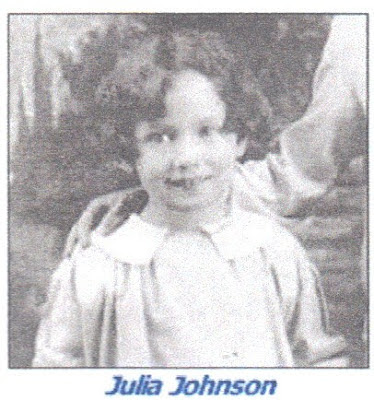Winnipeg’s most poignant mystery
by Robert A. Waters
On the afternoon of April 28, 1928, five-year-old Julia Johnson disappeared from her front yard at 128 Austin Street in Winnipeg.
The Winnipeg Free Press reported that “shortly before 3:00 Wednesday afternoon Julia was playing outside her home with a [tennis] ball. Her mother, who was in the house at the time, had spoken to her a few minutes previous. A woman who lives next door and is a close friend of the Johnsons had noticed the child playing, too, and had told her not to go away. ‘No, I won’t,’ Julia had replied. ‘I’m just playing here.’”
Five minutes later, her mother checked on her and she was gone.
Julia was described as a very pretty girl. When last seen, she wore a red and black dress, black shoes, fawn-colored stockings and a brown toque. She weighed about forty pounds, had blue eyes and dark brown hair.
Local police launched a massive hunt for the missing girl. Boy scouts, schoolboys, and neighbors joined in, searching nearby homes, fields, forests, and sewers. A trained police dog sniffed around Julia's home but found no leads. Police questioned neighbors, transients, and known “deviants.”
Winnipeg, located in Manitoba, was a close-knit, blue-collar community with many European immigrants. In 1928, neighbors watched out for one another.
After her child vanished, journalists reported that Julia’s mother had “taken to her bed” while her father continued to search. Though poor, the Johnsons offered a reward of $50 for their daughter, dead or alive. Nine days later, the Winnipeg City Council added $100 to the reward fund.
Two weeks after Julia went missing, dozens of Spiritualists and mediums met in an attempt to shed light on the whereabouts of the missing child. No helpful results came from the meeting.
On Halloween, Mrs. Johnson sat in the dark all night waiting for her daughter to return. According to the Winnipeg Free Press, “Mrs. Johnson has been nursing a hope for the past few weeks that perhaps Julia had been kidnapped and held away for spite, that the guilty person might consider the punishment sufficient and endeavor to return her to the vicinity of her home on Halloween night, when masks would make the venture look like another Halloween prank.” The night came and went with no contact and the disappointed mother sank back into despair.
In November, Dr. A. Maximilian Langsner, a famous Viennese criminologist on tour in Canada, met with Mrs. Johnson. Declaring that the child was still alive, he stated that he would find her. Langsner claimed to use “psychic thought processes” to solve crimes. His psychic powers must have failed him in this case, however, because he never made good on his promise.
The police, frustrated by a complete lack of leads, continued to investigate the case for years.
Finally, on March 22, 1937, a worker at an old cigar factory made a startling discovery. While dismantling a boiler, he found the skeleton of a child. Journalists reported that “it lay crouched at the far end of a rusty old boiler in the basement of a warehouse at 187 Southerland Avenue [within sixty feet of the Johnson’s back fence].” The remains were fully clothed. Sitting on top of the bones lay a tennis ball.
The Winnipeg Free Press reported: “The theory that [Julia] might have crawled into the boiler in which her remains were discovered Monday afternoon was exploded...when it became fairly plain that she had been shoved in. Her assailant, apparently, had placed the end of a pole, or possibly a long pipe, against her stomach, and shoved her to the far end of the rusted metal boiler that was to be her tomb for nine years. That much, at least, was revealed by the bent position of the skeleton...” A long, rusty pole was found on the floor beside the boiler.
The coroner said: “Everything points to the body having been doubled up and thrust into the boiler.”
In 1928, the Western Wicker Products factory, makers of “willow furniture,” had occupied the building. Investigators speculated that varnish used in the basement may have masked any odor from the decomposing body.
The next year, as the Depression struck, the business folded.
Eighteen workers helped produce the furniture. Police set out to find the employees but many had moved to other areas of Canada. Several now lived in the United States, and one had returned to his native Yugoslavia. Detectives never tracked down all the employees.
Did five-year-old Julia Johnson wander down to the busy factory, enter without being seen, walk down into the basement, crawl into the rusty boiler, and somehow struggle her way to the very back in a “doubled-up” position?
Or is it more likely that some anonymous deviant (possibly a worker at the factory) got away with cold-blooded murder?



No comments:
Post a Comment